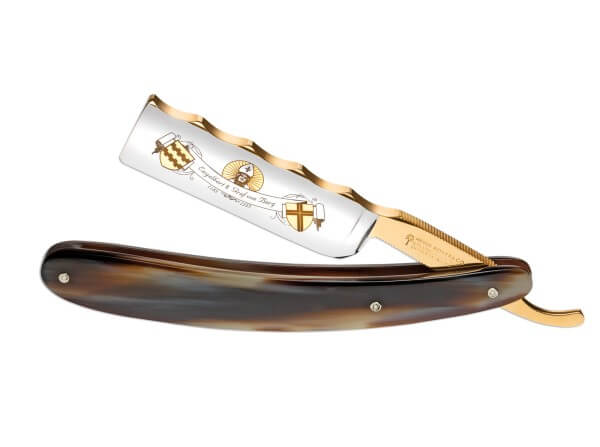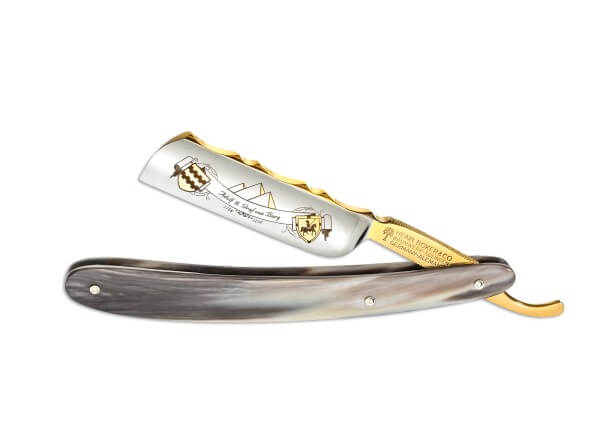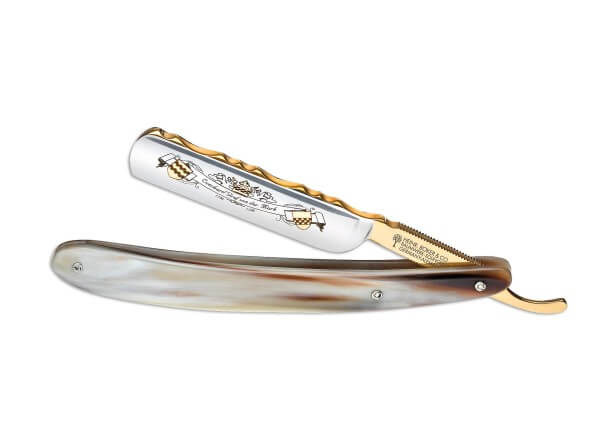Not far from the company headquarters of the Boker Manufactory in Solingen, we find the hallmark of the Bergisches Land region, the castle Burg an der Wupper. It is also one of the largest castles in western Germany, and the largest reconstructed castle in the state of North Rhine-Westphalia. The famous history of Castle Burg is inseparably linked to the Duchy Berg and the Count of Berg (Haus Berg, 1068-1225). On this occasion we decided to dedicate a series of straight razors to the three counts of Berg, which symbolizes parts of their lives. This tribute is reminiscent of the remarkable property and influence of the counts with impressive adornments made from 24-karat gold. Adolf II, Count of Berg, built the new castle (”Novus Mons,“ today known as Castle Burg) at the Wupper, erected on top of a preceding for tress from the 10th century. The influence and wealth of Count Adolf II of Berg in the Rheinland-Westfalen region was tremendous. In those days, it was commonplace to split the inheritance among the six sons of Adolf. However, this represented a problem for the house of Berg, since this division would reduce the value and cost the Berg dynasty its influence. Since his eldest son (also Adolf) had already died in 1148 at Damascus during the Second Crusade, his sons Friedrich and Bruno entered into the clergy, and his youngest son Adolf was excluded from the inheritance due to his young age. In 1160, the Bergish realm was split between Adolf’s sons Everhard and Engelbert.
EVERHARD, COUNT OF THE MARK
Everhard, older than Engelbert, received the Westphal ian possessions with the castles Altena and Hovel, and the abbeys Werden, Essen, and Cappenberg. This shows that for Adolf II, the Rhine-Franconia possessions were likely of lower value compared to the Westphalian. Everhard founded the Altenaer line - his descendants later called themselves Counts of the Mark.
ADOLF III, COUNT OF BERG Engelbert I of Berg received the Rhine-Franconia inheritance and continued the name Berg in his family. The center of his domain was the castle Burg an der Wupper, which was built by his father (Adolf II). Engelber t I died in 1189 during the Third Crusade. His oldest son, Adolf III, succeeded him as Count of Berg. His reign fell on a period of warring conflicts, which led to his participation in the Crusades. Adolf went to the Holy Land during the Fifth Crusade in 1218, and died from an epidemic on August 7 of that year, as Commander of the Rhine and Friesian siege troops at Damiette in the Nile Delta. He had no son, therefore the Altena-Berg branch ceased.
ENGELBERT II, COUNT OF BERG
After the death of Adolf III, the House of Limburg, into which Adolf ‚s daughter Irmgard had married, staked its claim to the entire Bergish estate. While the daughter of Adolf III was entitled to an inheritance even in that time, Engelbert II, the brother of Adolf III, claimed the inheritance for himself. The resulting dispute was not settled in a legal process, but by violence over the course of two feuds. Engelbert rejected the Limburg claim through the force of arms and took over the rule of the County Berg as Engelbert II. Engelbert II, Count of Berg, later called ”The Holy,” was also known as Engelbert I, Archbishop of Cologne. With his murder in 1225, the Bergish counts in this line came to an end, as the male line of the Bergish counts ended with the death of Engelbert II. As a result, Berg went to House Limburg, which was thus finally able to assert its inheritance claim.











